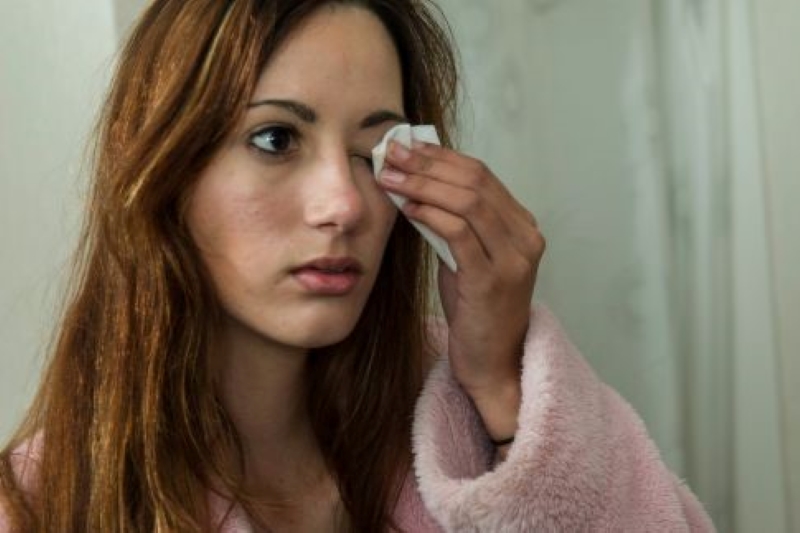
Eye health: prevent conjunctivitis, blepharitis, chalazions and allergies with eye wipes
In order to protect our eyes from all eye diseases of the anterior segment, especially conjunctivitis and allergies typical of the spring period, proper eye hygiene is essential, which can be carried out with simple sterile eye wipes
It is also very important to control blepharitis with correct ocular hygiene: chronic inflammations that are really annoying and tend to become chronic, characterised by the presence of very small skin scales or ‘debris’ of an oily consistency on the free eyelid edge (eyelid margin) or at the level of the eyelash implant.
Eye diseases: prevention of conjunctivitis and eyelid hygiene
Having well-clean eyelids is crucial for eye health.
In fact, the eye’s first effective defensive barrier is formed by the eyelids, eyelashes and the lachrymal film.
Proper cleansing of the entire eye and periocular area is not only important for a natural feeling of well-being, but also significantly limits the possibility of bacterial and ‘parasitic’ infections (e.g. pediculosis of the eyelashes).
Hygiene eye wipes
The use of disposable wipes specifically for the eyes that have a cleansing, emollient, soothing, protective action is especially useful in cases of predisposition to chronic or allergic eye diseases: blepharitis, conjunctivitis, blepharo-conjunctivitis, eyelid and conjunctival allergic phenomena.
There are various types of sterile eyelid hygiene wipes: some are designed only for eyelid cleansing to be used in normal daily cleansing of the eye or to cleanse eyelid and eyelash make-up residues well.
These eye wipes are made of soft material, soaked in solutions of exclusive cleansing, soothing and emollient substances for a specific ocular hygiene action that cleanses and provides not only an immediate sense of well-being, but also safe and fundamental hygiene.
The wipes are generally made of ‘non-woven’ material, they are soft to the touch and guarantee gentle but at the same time very effective cleansing. They contain no pharmacological, toxic or particularly aggressive substances for the eyelids and eyelashes.
The eye wipes are a valuable support to accompany topical or local therapy with eye drops or ophthalmic ointments in the treatment of inflammatory conditions of the conjunctiva and eyelid.
They are practical for daily use and do not require rinsing the eye after their use, and they are usually just the right size to guarantee a simple and daily ocular hygiene manoeuvre in perfect safety and manageability, without ever having the fear of touching an inflamed area.
Eye Wipes for Medicated Cleansing
There are also sterile wipes that allow medicated cleansing of the eyelids.
These are eye wipes similar to the others, but soaked in active ingredients (such as bisabolol + chlorhexidine or echinacea + pineapple sativum), which also have a strongly soothing and effectively antiseptic action.
This type of product is used to supplement local or topical medical therapy both pre- and post-surgery (cataract surgery, refractive surgery, vitreoretinal surgery, intravitreal injections, chalazi surgery, pterygium, entropion, ectropion, ptosis or blepharoplasty), as well as in cases of chronic or acute inflammatory diseases (blepharitis, blepharoconjunctivitis and keratoconjunctivitis), especially in springtime when flowering and pollination are a risk for us all.
How are eye wipes used?
After thoroughly cleaning your hands, you open the sachet and take out the eye wipe or gauze.
The eye wipe is passed gently over the eyelids and peri-ocular area to cleanse and remove eye secretions, deposits from the eyelids or eyelashes (smog, atmospheric dust, dust, air pollution).
They can also be used by contact lens wearers and safely before and after ocular microsurgery.
Read Also
Emergency Live Even More…Live: Download The New Free App Of Your Newspaper For IOS And Android
Dry Eye Syndrome: How To Protect Your Eyes From PC Exposure
Autoimmune Diseases: The Sand In The Eyes Of Sjögren’s Syndrome
Dry Eye Syndrome: Symptoms, Causes And Remedies
How To Prevent Dry Eyes During Winter: Tips
Blepharitis: The Inflammation Of The Eyelids
Blepharitis: What Is It And What Are The Most Common Symptoms?
Stye, An Eye Inflammation That Affects Young And Old Alike
Blurred Vision, Distorted Images And Sensitivity To Light: It Could Be Keratoconus
Stye Or Chalazion? The Differences Between These Two Eye Diseases
Blepharoptosis: Getting To Know Eyelid Drooping
Lazy Eye: How To Recognise And Treat Amblyopia?
Corneal Keratoconus, Corneal Cross-Linking UVA Treatment
Keratoconus: The Degenerative And Evolutionary Disease Of The Cornea
Burning Eyes: Symptoms, Causes And Remedies
What Is The Endothelial Count?
Ophthalmology: Causes, Symptoms And Treatment Of Astigmatism
Asthenopia, Causes And Remedies For Eye Fatigue
Blepharitis: What Is It And What Does Chronic Inflammation Of The Eyelid Entail?
Inflammations Of The Eye: Uveitis
Myopia: What It Is And How To Treat It
Presbyopia: What Are The Symptoms And How To Correct It
Nearsightedness: What It Myopia And How To Correct It
Blepharoptosis: Getting To Know Eyelid Drooping
Lazy Eye: How To Recognise And Treat Amblyopia?
What Is Presbyopia And When Does It Occur?
Presbyopia: An Age-Related Visual Disorder
Blepharoptosis: Getting To Know Eyelid Drooping
Rare Diseases: Von Hippel-Lindau Syndrome
Rare Diseases: Septo-Optic Dysplasia
Diseases Of The Cornea: Keratitis
Dry Eyes In Winter: What Causes Dry Eye In This Season?
Why Do Women Suffer From Dry Eye More Than Men?
Keratoconjunctivitis: Symptoms, Diagnosis And Treatment Of This Inflammation Of The Eye


